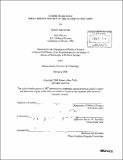| dc.contributor.advisor | Harvey M Sapolsky. | en_US |
| dc.contributor.author | Zirkle, Robert Allen | en_US |
| dc.contributor.other | Massachusetts Institute of Technology. Dept. of Political Science. | en_US |
| dc.date.accessioned | 2009-08-26T17:13:35Z | |
| dc.date.available | 2009-08-26T17:13:35Z | |
| dc.date.copyright | 2008 | en_US |
| dc.date.issued | 2008 | en_US |
| dc.identifier.uri | http://hdl.handle.net/1721.1/46655 | |
| dc.description | Thesis (Ph. D.)--Massachusetts Institute of Technology, Dept. of Political Science, 2008. | en_US |
| dc.description | Includes bibliographical references (p. 309-346). | en_US |
| dc.description.abstract | Intra-service politics can help explain many behaviors and outcomes across a variety of military services and countries. The thesis begins by developing a framework for understanding intra-service politics based on a review of organization theory. Every military service contains a variety of communities or unions organized by specific missions, functions or technologies. These communities compete with one another to determine a service's dominant culture and missions; and the distribution of a service's budgets, equipment and personnel. Three patterns intra-service relations are proposed: a strong and independent central leadership capable of acting as an honest broker between competing communities (e.g., the German Army of the interwar period); a single monarchical community dominating a service (e.g., the U.S. Air Force); and an oligarchy of communities controlling a service (e.g., the U.S. Army). In the latter two patterns, doctrinal developments, capabilities, and distribution of resources will mirror and tend to reinforce the power of the dominant unions. In order to test the relevancy and plausibility of the oligarchic pattern, the bulk of the thesis is taken up with three case studies examining the division design process in the U.S. Army during the 1970s and 1980s: the Division 86 design, the High Technology Light Division, and the Light Infantry Division. Overall, the evidence from these three case studies suggests the utility of an explanation based on intra-service community politics for certain behaviors. Moreover, it suggests a U.S. Army dominated by an oligarchy composed of an armored/mechanized infantry ("heavy") community, an artillery community, an aviation community and a light infantry community. The oligarchy itself has a multi-tiered structure, one where the light infantry community has the least power and influence, while the heavy and artillery communities have the most; the aviation community occupies a position in-between, wielding considerable power but never being the equal of the two dominant ground force communities. | en_US |
| dc.description.statementofresponsibility | by Robert Allen Zirkle. | en_US |
| dc.format.extent | 346 p. | en_US |
| dc.language.iso | eng | en_US |
| dc.publisher | Massachusetts Institute of Technology | en_US |
| dc.rights | M.I.T. theses are protected by
copyright. They may be viewed from this source for any purpose, but
reproduction or distribution in any format is prohibited without written
permission. See provided URL for inquiries about permission. | en_US |
| dc.rights.uri | http://dspace.mit.edu/handle/1721.1/7582 | en_US |
| dc.subject | Political Science. | en_US |
| dc.title | Communities rule : intra-service politics in the United States Army | en_US |
| dc.title.alternative | Intra-service politics in the United States Army | en_US |
| dc.type | Thesis | en_US |
| dc.description.degree | Ph.D. | en_US |
| dc.contributor.department | Massachusetts Institute of Technology. Department of Political Science | |
| dc.identifier.oclc | 427059201 | en_US |
